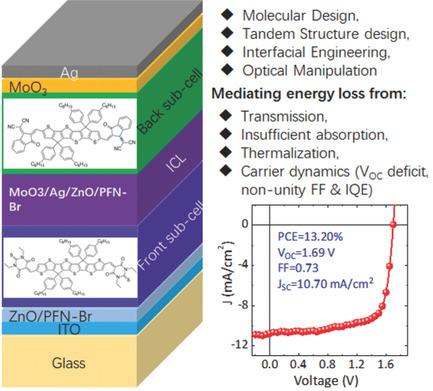当前位置:
X-MOL 学术
›
Adv. Mater.
›
论文详情
Our official English website, www.x-mol.net, welcomes your feedback! (Note: you will need to create a separate account there.)
Tackling Energy Loss for High‐Efficiency Organic Solar Cells with Integrated Multiple Strategies
Advanced Materials ( IF 29.4 ) Pub Date : 2018-03-13 , DOI: 10.1002/adma.201706816 Lijian Zuo 1 , Xueliang Shi 1 , Sae Byeok Jo 1 , Yun Liu 2 , Fracis Lin 1 , Alex K.-Y. Jen 1, 2, 3
Advanced Materials ( IF 29.4 ) Pub Date : 2018-03-13 , DOI: 10.1002/adma.201706816 Lijian Zuo 1 , Xueliang Shi 1 , Sae Byeok Jo 1 , Yun Liu 2 , Fracis Lin 1 , Alex K.-Y. Jen 1, 2, 3
Affiliation

|
Limited by the various inherent energy losses from multiple channels, organic solar cells show inferior device performance compared to traditional inorganic photovoltaic techniques, such as silicon and CuInGaSe. To alleviate these fundamental limitations, an integrated multiple strategy is implemented including molecular design, interfacial engineering, optical manipulation, and tandem device construction into one cell. Considering the close correlation among these loss channels, a sophisticated quantification of energy‐loss reduction is tracked along with each strategy in a perspective to reach rational overall optimum. A novel nonfullerene acceptor, 6TBA, is synthesized to resolve the thermalization and VOC loss, and another small bandgap nonfullerene acceptor, 4TIC, is used in the back sub‐cell to alleviate transmission loss. Tandem architecture design significantly reduces the light absorption loss, and compensates carrier dynamics and thermalization loss. Interfacial engineering further reduces energy loss from carrier dynamics in the tandem architecture. As a result of this concerted effort, a very high power conversion efficiency (13.20%) is obtained. A detailed quantitative analysis on the energy losses confirms that the improved device performance stems from these multiple strategies. The results provide a rational way to explore the ultimate device performance through molecular design and device engineering.
中文翻译:

解决具有多种策略的高效有机太阳能电池的能量损失
由于受到来自多个通道的各种固有能量损失的限制,与传统的无机光伏技术(例如硅和CuInGaSe)相比,有机太阳能电池的器件性能较差。为了缓解这些基本局限性,我们实施了一种集成的多种策略,包括分子设计,界面工程,光学操作以及将串联装置构建到一个单元中。考虑到这些损失通道之间的密切相关性,我们会从每种策略的角度跟踪对能耗降低的复杂量化,以达到合理的总体最优水平。合成了一种新的非富勒烯受体6TBA,以解决热化和V OC损耗,另一个小带隙非富勒烯受体4TIC用于后部子电池中,以减轻传输损耗。串联架构设计显着降低了光吸收损耗,并补偿了载流子动力学和热损耗。界面工程进一步降低了串联架构中载流子动力学带来的能量损失。由于这一共同努力,获得了很高的功率转换效率(13.20%)。对能量损失进行的详细定量分析证实,改进的设备性能源于这些多种策略。结果为通过分子设计和器件工程探索最终的器件性能提供了一种合理的方法。
更新日期:2018-03-13
中文翻译:

解决具有多种策略的高效有机太阳能电池的能量损失
由于受到来自多个通道的各种固有能量损失的限制,与传统的无机光伏技术(例如硅和CuInGaSe)相比,有机太阳能电池的器件性能较差。为了缓解这些基本局限性,我们实施了一种集成的多种策略,包括分子设计,界面工程,光学操作以及将串联装置构建到一个单元中。考虑到这些损失通道之间的密切相关性,我们会从每种策略的角度跟踪对能耗降低的复杂量化,以达到合理的总体最优水平。合成了一种新的非富勒烯受体6TBA,以解决热化和V OC损耗,另一个小带隙非富勒烯受体4TIC用于后部子电池中,以减轻传输损耗。串联架构设计显着降低了光吸收损耗,并补偿了载流子动力学和热损耗。界面工程进一步降低了串联架构中载流子动力学带来的能量损失。由于这一共同努力,获得了很高的功率转换效率(13.20%)。对能量损失进行的详细定量分析证实,改进的设备性能源于这些多种策略。结果为通过分子设计和器件工程探索最终的器件性能提供了一种合理的方法。



























 京公网安备 11010802027423号
京公网安备 11010802027423号